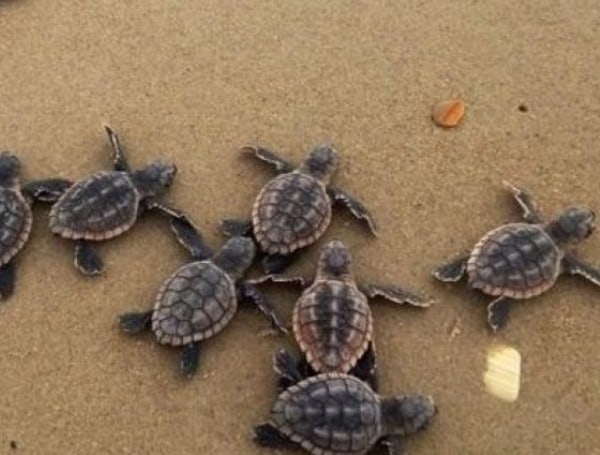As the warm embrace of spring envelops Florida’s sun-drenched shores, a remarkable natural spectacle unfolds – the annual sea turtle nesting season.
From March through October, these ancient mariners embark on an extraordinary journey, leaving the vast expanse of the ocean to seek out the very beaches where they were born, continuing a cycle of life that has endured for millions of years.
Florida’s coastlines play host to one of the world’s most significant nesting aggregations for several sea turtle species, including the loggerhead, green, and leatherback turtles.
Read: Spring Hill Man Gets 15 Months In Prison For Trafficking Turtles
These majestic creatures, however, face numerous challenges, with all seven species classified as either threatened or endangered under the Endangered Species Act.
Consequently, their conservation has become a paramount priority for wildlife agencies, environmental organizations, and dedicated volunteers across the state.
To safeguard these ancient mariners, a comprehensive monitoring program is in place. The Florida Fish and Wildlife Conservation Commission’s (FWC) Fish and Wildlife Research Institute coordinates two crucial initiatives: the Statewide Nesting Beach Survey (SNBS) and the Index Nesting Beach Survey (INBS).
The INBS focuses on a standardized set of index beaches, meticulously recording nest counts to determine nesting trends over time. This data serves as a vital tool for conservation efforts, providing insights into population dynamics and guiding management strategies.
The SNBS, on the other hand, is a collaborative endeavor involving numerous stakeholders, including state and federal agencies, non-profit organizations, and dedicated volunteers. This extensive survey covers the entirety of Florida’s coastline, documenting nesting activity and gathering invaluable data on the geographical distribution and density of sea turtle nests.
Read: FWC Releases New Decals To Help Conservation Of Florida Sea Turtle, Manatee Habitats
Each morning during the nesting season, teams of trained surveyors diligently comb the beaches, meticulously recording the number of turtles that have ventured ashore overnight to lay their eggs. Their efforts are supplemented by citizen science programs, such as the Loggerhead Sea Turtle Nest Excavation initiative, which engages the public in hands-on conservation activities.
Loggerhead Turtles: Guardians of the Southeastern Shores
The loggerhead turtle, with its distinctive reddish-brown carapace, holds a special place in Florida’s conservation efforts. The southeastern United States hosts the world’s largest nesting aggregation of this species, with Florida playing a pivotal role in ensuring its survival.
Researchers and volunteers work tirelessly to monitor and protect loggerhead nests, shielding them from predators and human disturbances. Their efforts have yielded promising results, with some beaches witnessing record-breaking nesting activity in recent years.
Green Turtles: A Remarkable Resurgence
Florida’s green turtle nesting aggregation is the second largest in the Western Atlantic Hemisphere, and its remarkable recovery is a testament to the efficacy of conservation measures. Once critically endangered, these gentle giants have made a remarkable comeback, with nesting numbers steadily increasing over the past few decades.
Dedicated teams meticulously document and safeguard green turtle nests, ensuring that these ancient mariners have a fighting chance at survival in the face of numerous threats, including habitat loss, pollution, and illegal poaching.
Read: Do Your Part For Nesting Sea Turtles, Shorebirds On Florida Beaches
Leatherback Turtles: Florida’s Unique Distinction
Florida holds a unique distinction as the only state in the continental United States where leatherback turtles, the largest of all sea turtle species, regularly nest. These massive creatures, with their distinctive leathery carapaces, undertake epic migrations across vast ocean basins to reach Florida’s shores.
While their numbers are relatively small compared to other species, the presence of leatherback nests is a cause for celebration among conservationists. Rigorous monitoring and protection efforts are in place to ensure the continued survival of these gentle giants within Florida’s coastal ecosystems.
Nesting Hotspots: Where Nature’s Wonders Unfold
Certain regions within Florida have emerged as nesting hotspots, attracting a significant number of sea turtles each year. One such location is John D. MacArthur Beach State Park, where the 2023 nesting season has already set remarkable records. Loggerhead sea turtles laid a record 2,068 nests, while green sea turtles established a new high with 2,116 nests. Leatherback sea turtles, too, left their mark with 56 nests, more than doubling the previous year’s count.
Read: Analyzing Sea Turtle Sickness, UF Researchers Discover They Can Pull Human DNA From Thin Air
Minimizing Human Impacts
While conservation efforts are crucial, minimizing human impacts on nesting sites is equally important. Beachgoers and residents are urged to exercise caution and follow specific guidelines during the nesting season to ensure the safety of these ancient mariners and their offspring.
One of the primary concerns is the disruptive effect of artificial lighting, which can disorient nesting turtles and hatchlings, causing them to stray from their intended paths. Consequently, coastal communities are encouraged to implement lighting ordinances and promote the use of turtle-friendly lighting fixtures that minimize the impact on nesting sites.
Additionally, beachgoers are advised to avoid disturbing nesting sites, leaving no trace of their presence on the sand. Simple actions, such as removing beach furniture and filling in holes before leaving, can make a significant difference in protecting these vulnerable creatures.
Education and Outreach: Fostering a Lasting Legacy
Ensuring the long-term survival of sea turtles in Florida requires more than just on-the-ground conservation efforts. Education and outreach initiatives play a crucial role in fostering a lasting legacy of environmental stewardship.
Read: Florida Man Pleads Guilty To Smuggling Wild-Caught Turtles To Hong Kong And Germany
Organizations like the FWC and various non-profit groups offer educational programs and workshops, engaging the public in hands-on activities and fostering a deeper appreciation for these ancient mariners. By cultivating a sense of wonder and understanding, these initiatives aim to inspire future generations to become active participants in the ongoing efforts to protect Florida’s sea turtle populations.
Help support the Tampa Free Press by making any small donation by clicking here.
Android Users, Click To Download The Tampa Free Press App And Never Miss A Story. Follow Us On Facebook and Twitter. Sign up for our free newsletter.


